|
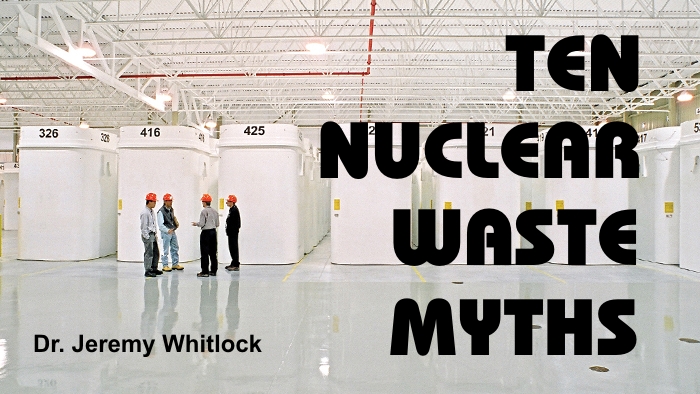
Today many countries with nuclear power programs are developing, or plan to develop, a deep geological repository (DGR) for the long-term isolation of used nuclear reactor fuel. The DGR concept involves deep entombment of the used nuclear fuel in stable rock formations for millennia, reflecting both state-of-the-art science and engineering, as well as several aspects of nature's own geological repositories for isolating concentrated radioactive material from the biosphere (for example, the high-grade uranium ore deposits in the Athabasca Basin of western Canada, over a billion years old).
The first operational DGR for used nuclear fuel will be located in Finland, now in the final steps of construction prior to accepting used nuclear fuel from that country's reactors. In Canada the Nuclear Waste Management Organization (NWMO) is nearing the end of a lengthy process to select a suitable site for a DGR in Ontario (to be announced in 2024).
Used nuclear fuel refers to reactor fuel that has been removed from a nuclear reactor following its period of service. It's called "used" since, in addition to containing all of the radioactive waste products from its time in the reactor, it still contains a significant amount of potential energy that could be extracted (about a hundred times more) using advanced reactor designs and waste reprocessing techniques - so in this context it's not really "waste" at all. In fact, depending on the details of this advanced technology, much of the long-term radioactive waste products would potentially also be destroyed in the process of this recycling operation.
However, since (a) this advanced recycling technology (on the necessary scale) is not commercially available, and (b) uranium resources are reasonably abundant on earth, many countries seeking to address their nuclear waste challenge during the current generation's stewardship (a key tenet of sustainable development) have adopted a two-pronged approach consisting of:
- safely storing used nuclear fuel in surface facilities that can last hundreds of years if needed; and
- developing, at the same time, a long-term solution that addresses the time period during which the used nuclear fuel remains a significant hazard.
There is unfortunately much misunderstanding and misinformation in the public on this topic. The following addresses ten of the more common "myths".
NUCLEAR WASTE MYTH #1:
|
We've been running nuclear reactors since the 1950s with no idea about what to do with the waste.
|
REALITY:
|
Responsible waste management has been part of nuclear operations since the beginning. Nuclear spent fuel is stored in protective pools at each reactor site, and after about ten years is transferred to robust dry storage units – a process that can continue safely for hundreds of years if necessary (sometimes referred to as rolling stewardship). Looking ahead a million years – past multiple glaciations that destroy everything on the surface – is something we simply don't do for any form of waste, except for nuclear waste. For 50 years Canada and other countries have been preparing a long-term safe solution for nuclear spent fuel, making it the only waste product of modern society with a true long-term plan.
|
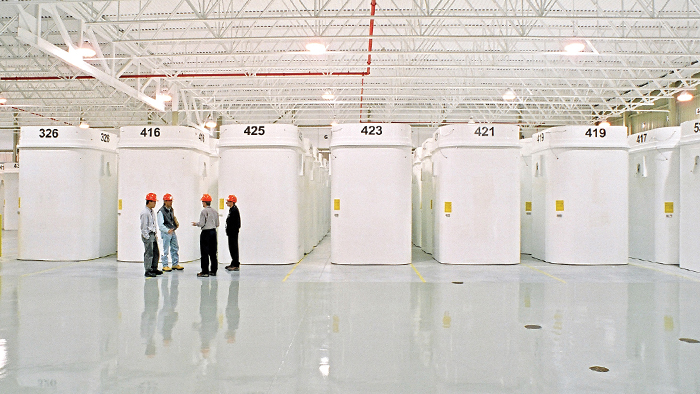
Storage of used nuclear fuel in Ontario. Each container equals 160,000 tonnes of coal (25 km of railcars)
NUCLEAR WASTE MYTH #2:
|
A Deep Geological Repository (DGR) involves placing nuclear waste into a watershed, risking contamination of drinking water for future generations.
|
REALITY:
|
The design of a Deep Geological Repository (DGR) puts the nuclear waste hundreds of metres below ground, in a region of rock that isn't in direct contact with the watershed – which the repository is designed to protect. The waste containers are emplaced in stable, uniform rock (crystalline or sedimentary), containing ground water that's been isolated there for millions of years. The water has been there that long because, in the absence of large fractures and other discontinuities, the only way it can move is by slow diffusion through microscopic spaces between grains or crystals in the rock structure ('micropores'). This process takes thousands of years to move a short distance, and is random: nothing drives the water upwards towards the watershed. Since every location on the surface is on a watershed to somewhere, the only way to avoid a watershed for the long term is to go deep underground.
|

DGRs isolate the used fuel in a region of stable rock deep below the watershed.
NUCLEAR WASTE MYTH #3:
|
No container lasts forever, and therefore leakage into the environment is inevitable.
|
REALITY:
|
The Deep Geological Repository (DGR) concept does not depend on containers lasting forever (and it would not meet its main objective if it did). Although each 3-tonne steel, copper-coated used-fuel container (UFC) in the Canadian DGR concept is expected to survive the duration of the radioactive hazard (hundreds of thousands of years), protecting against leakage is part of the plan too. In this case, multiple barriers stand in the way of radioactive material making its way upwards to the environment – starting with the metallic fuel bundles themselves, and the solid, ceramic fuel pellets within that would first need to dissolve. Once outside the UFC, any radioactive material dissolved in groundwater would then encounter layers of bentonite clay designed to impede water flow, followed by approximately 500 metres of host rock – which was chosen for its inability to transport groundwater (about a metre of movement every 1000 years). This design ensures that – whether containers last or containers leak – the environment will never encounter the radioactive hazard of the spent fuel.
|
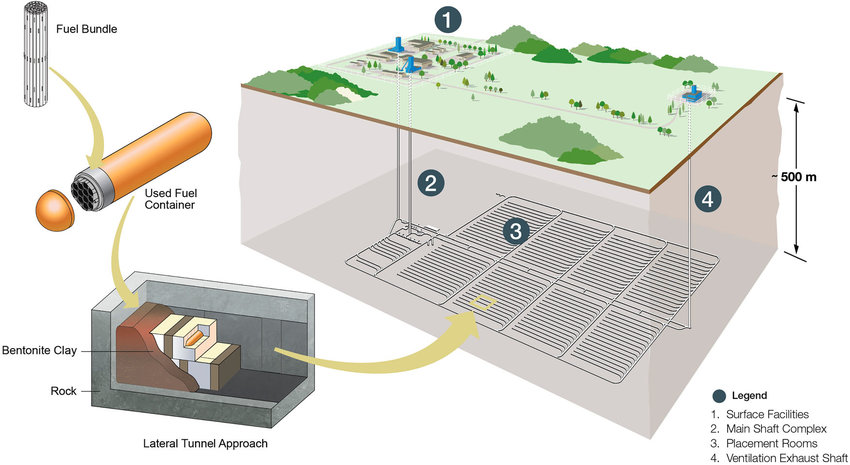
Plan for a deep geologic repository for used nuclear fuel in Canada (courtesy: NWMO)
NUCLEAR WASTE MYTH #4:
|
Repackaging of the used nuclear fuel at the site will create a significant risk of environmental contamination.
|
REALITY:
|
The transfer of radioactive used fuel from the transport container to the underground container, using a heavily shielded, remotely-operated facility (called a 'hot cell'), is an activity in which Canada has over seven decades of safe experience. The process at the Deep Geological Repository hot cell will involve specially trained operators remotely moving each solid, 23-kg fuel bundle from the transport container to the underground used-fuel container (UFC), then sealing the UFC once full. All of this takes place within a shielded, fully contained and secure environment, licensed by the Canadian Nuclear Safety Commission. At no point is radioactive material removed from its primary package (the fuel bundle), and at no point are liquids or powders involved. There is no significant risk of environmental contamination from this process.
|
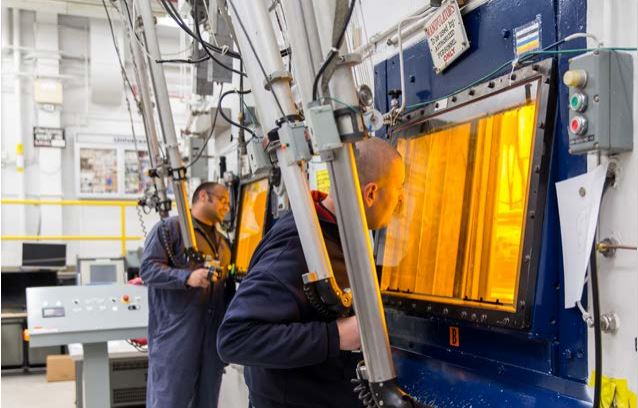
Safe handling of radioactive material using remote manipulators and a shielded "hot cell".
NUCLEAR WASTE MYTH #5:
|
There is no precedent for a Deep Geological Repository (DGR) since none has yet operated.
|
REALITY:
|
Although DGRs for used nuclear fuel are relatively new, we have decades of experience with DGRs for low and intermediate-level radioactive waste (e.g., the U.S. Waste Isolation Pilot Plant, WIPP, receiving transuranic waste since 1999), and Underground Research Labs (URLs) simulating DGR conditions – and in addition we have learned from the many examples of long-term isolation of highly radioactive material found in nature. One of the most useful of these is the high-grade uranium ore found at Cigar Lake in northern Saskatchewan. At approximately the same depth as the proposed Canadian DGR (roughly a half-kilometre), nature has kept over 100,000 tonnes of uranium isolated from the environment for over a billion years – with no radioactive signature at the surface. This isolation was achieved despite the ore's location in a region of porous sandstone saturated in groundwater (the opposite of DGR conditions), and without the benefit of a corrosion-resistant, protective container. What the ore did have was a layer of clay between it and the groundwater, which kept it from dissolving. This is the same concept used by a DGR, and provides a billion-year 'experiment' by nature that informs the work of scientists today.
|
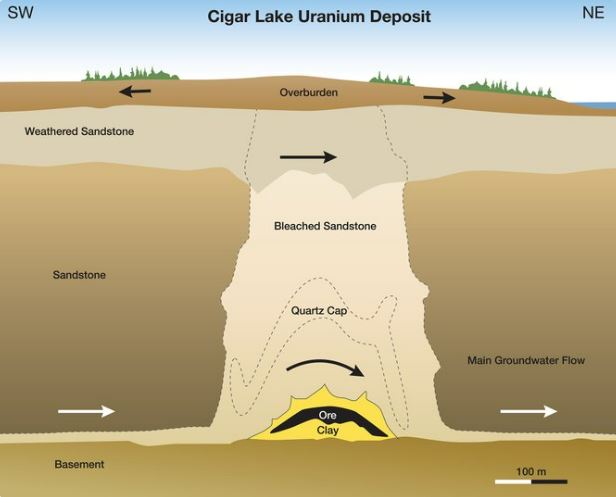
The Cigar Lake uranium deposit in northern Saskatchewan, Canada: nature's DGR.
NUCLEAR WASTE MYTH #6:
|
It's impossible to predict the safety of anything for a million years.
|
REALITY:
|
Under certain conditions it is possible to predict natural processes for long time scales, and this is the main reason for the development of the Deep Geological Repository concept: a problem with a geological time scale requires a geological solution. In particular, if one chooses a host rock with low seismicity, high homogeneity, low groundwater movement (permeability), and low mineral value – and if one furthermore finds these conditions in a sufficiently large and deep zone that is highly decoupled from the surface environment (and thus things like climate change – both warming and glaciation) – the uncertainty about future geological processes becomes low enough that meaningful extrapolations can be made over millennia based upon current models. The models themselves are verifiable against experimental studies (in both conventional and in-situ laboratories), as well as natural processes – including relevant geological processes that have been underway for millions of years, such as nature's own isolation of high-grade uranium deposits in northern Saskatchewan. The conditions for such long-term confidence are not likely to exist on the surface of the planet however: one must go either way above (outer space) or way below (deep geology).
|
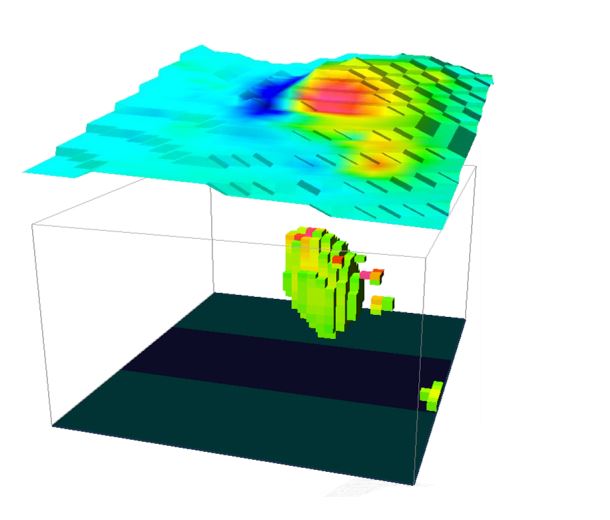
We are able to model a DGR and its surroundings with sufficient confidence to ensure long-term safety.
NUCLEAR WASTE MYTH #7:
|
Since accidents happen on the highways every day, environmental contamination from nuclear waste transportation is inevitable.
|
REALITY:
|
Used nuclear fuel has been transported safety for 60 years in Canada and internationally, using the strongest containers found on the road or rail today. These shipments are regulated by both Transport Canada and the Canadian Nuclear Safety Commission, and containers undergo a series of tests set by the International Atomic Energy Agency (IAEA) to demonstrate robustness against severe accidents. These tests include a free-drop test (9 m drop onto an unyielding surface), puncture test (1 m drop onto a steel rod), thermal test (800 deg C fire for 30 minutes), and two immersion tests (15 m for 8 hours, plus a 200 m extreme-pressure test). Importantly, these tests are designed not to simulate specific accidents, but to apply bounding conditions (e.g. forces, temperatures, pressures) that envelope the most severe accidents. For example, a UK test demonstrated that packages meeting the IAEA standard can survive a broadside collision with a locomotive travelling 160 km/h. Worldwide, thousands of shipments of used fuel (and millions of shipments of other highly radioactive materials) have been made in the last 60 years without a radiological incident.
|
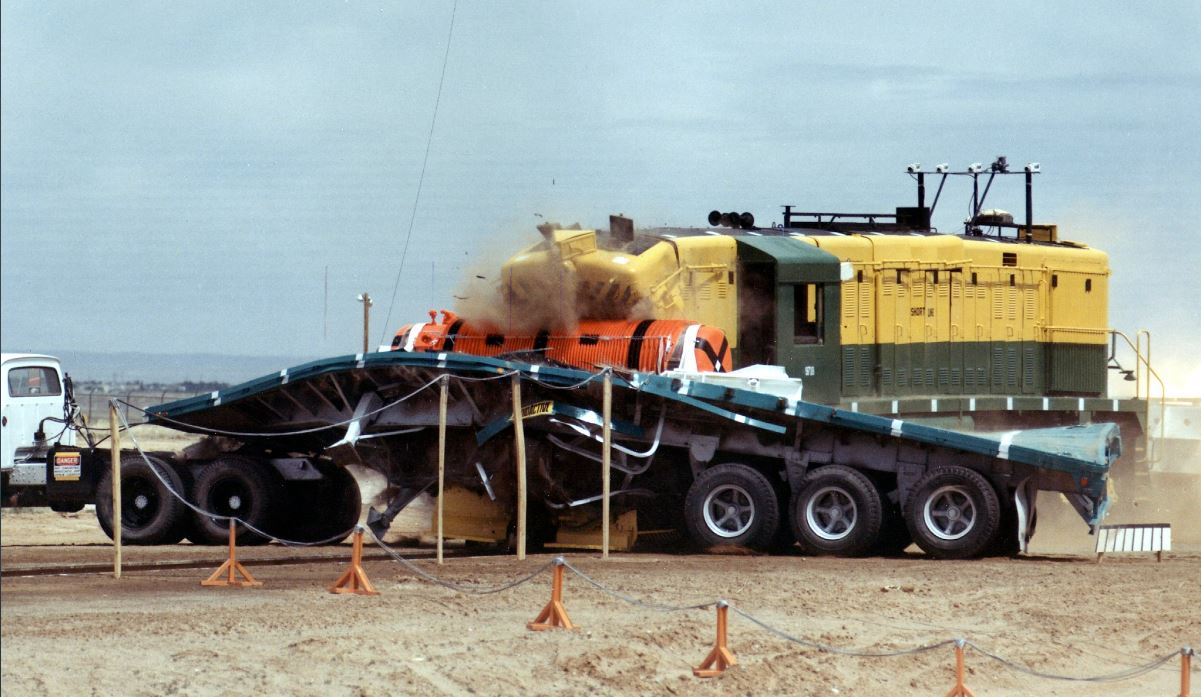
Train hitting a nuclear transport cask at 82 mph, tested in Albuquerque, New Mexico in 1978. (courtesy: Sandia Labs)
NUCLEAR WASTE MYTH #8:
|
Nuclear waste is the longest-lasting and most dangerous waste created on earth.
|
REALITY:
|
Used nuclear fuel is certainly long-lasting and very dangerous, but it is not the most extreme in either of these categories. Nuclear waste is probably the most publicized and regulated form of waste however – with a lifetime that can be precisely quantified – and this likely leads to the propagation of this myth. In fact, non-radioactive toxic elements last forever (e.g., cadmium, mercury, arsenic or lead found in car exhaust, pesticides, and photovoltaic cells), while any radioactive material starts disappearing the moment it's created. "Dangerous" can refer to the material itself, in which case it's interesting to note that the highest-risk material in long-term nuclear waste management – plutonium – is matched for toxicity, gram-for-gram, by caffeine (another interesting fact: there's roughly as much caffeine in a cup of coffee as there is plutonium in an irradiated 20 g CANDU fuel pellet). But more importantly "dangerous" can refer to risk of exposure, in which case used nuclear fuel pales in comparison to everyday waste exposures like car exhaust or fossil fuel emissions, which kill thousands each year and are in the process of impacting billions of lives through planetary climate change. Used nuclear fuel, on the other hand, is relatively easily managed and isolated since it is solid, contained, and relatively low in volume. In other words, used nuclear fuel may not be the longest-lasting nor most dangerous waste, but it's probably the longest-lasting and most dangerous waste that we are doing something about for the long term.
|
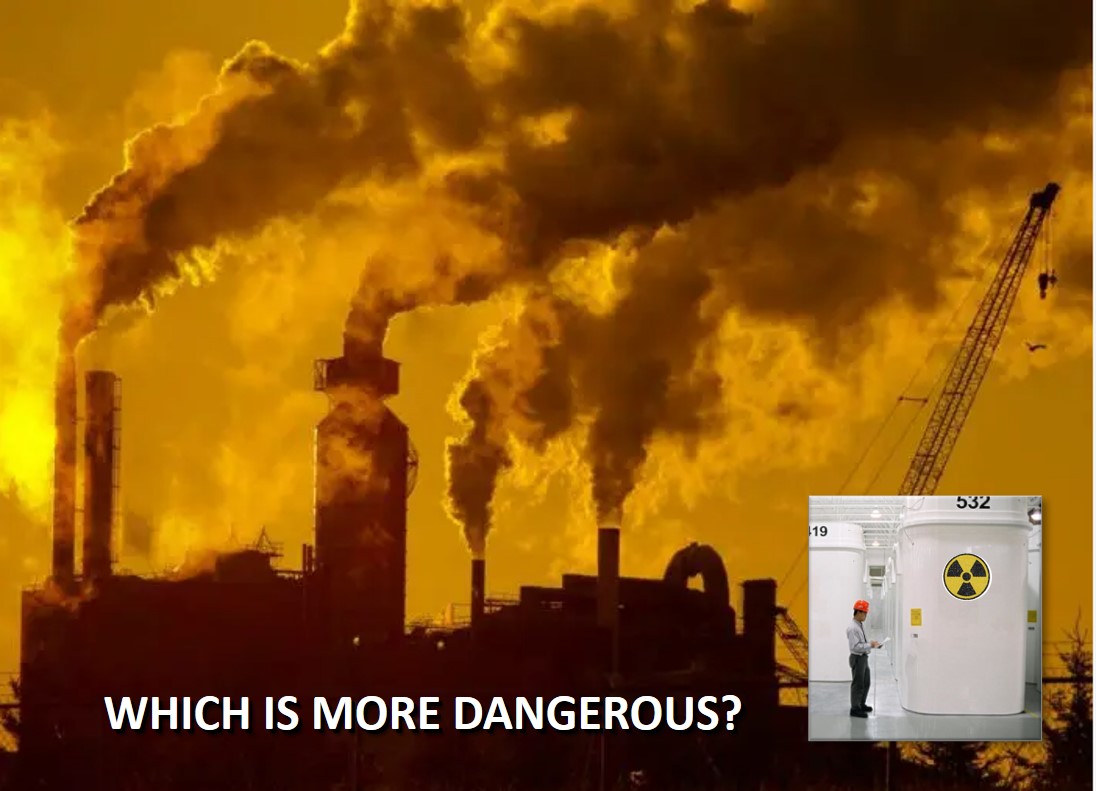
Risk assessment can be based on perception or science - sometimes with very different results.
NUCLEAR WASTE MYTH #9:
|
There is no safe level of radiation.
|
REALITY:
|
Radiation is all around us in nature – in our food, our water, the air we breathe, and the rocks and other materials we build with. Within the earth its heat helps keep our planet at a habitable temperature, and maintains the magnetic field protecting us from the most harmful parts of our sun's energy. In our hospitals it diagnoses and cures disease, and sterilizes single-use items such as syringes and band-aids. Since humans are part of nature, radiation is within each of us as well. Our bodies have evolved in this sea of energy, and this has given us an inherent resistance to its effects at low levels of exposure. Thus, at high doses radiation is dangerous; at low doses it is safe. In other words, at the levels of radiation we encounter every day – within us, around us, and including that from the nuclear industry and the proposed Deep Geological Repository – there is no observed health impact. There is, in fact, evidence that these low levels are actually beneficial to our health, but for public and occupational health protection purposes the international best practice is to assume a negative health impact at all levels. Unfortunately, this conservative assumption has led to a common misperception that low doses of radiation are not safe.
|
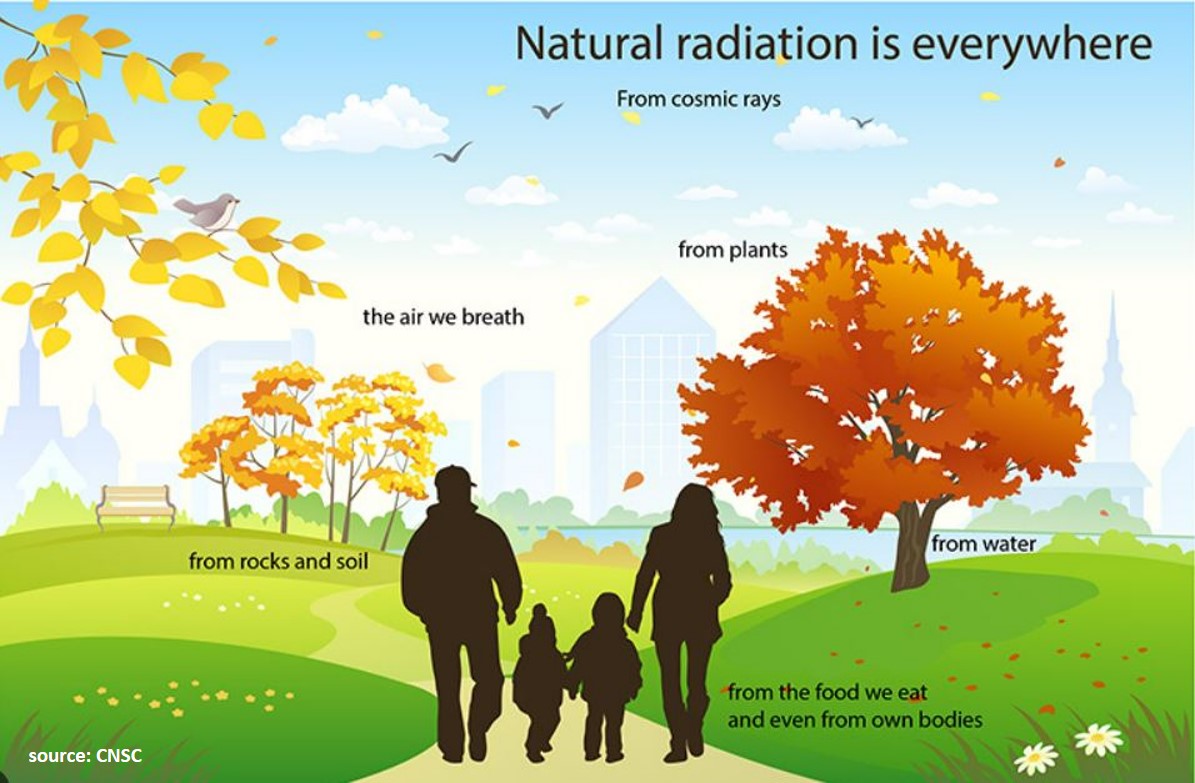
Radiation is a natural part of ourselves and our world. (courtesy: CNSC)
NUCLEAR WASTE MYTH #10:
|
A Deep Geological Repository (DGR) represents abandonment of nuclear waste.
|
REALITY:
|
While the DGR concept includes the eventual decommissioning of surface facilities and abandonment of the site, this does not imply that stewardship of the used nuclear fuel ends. On the contrary, the used nuclear fuel will continue to receive the careful and responsible management of the DGR concept for millennia afterwards, developed by thousands of international experts over two centuries of enquiry (by the time the first DGRs receive final closure). The used nuclear fuel will be safe from hurricanes, tornadoes, wars, terrorism, earthquakes, and glaciation. It will most likely be (unless society takes major new steps in this direction) the only waste on the planet with this level of long-term security, and the only waste not found in glacial till thousands of years from now by civilizations recolonizing former ice sheet zones in the next interglacial period. On this time scale, the concept of "stewardship" clearly has much broader scope than temporary control under the watchful eyes of humans (i.e., the status quo). It implies sustainable, long-term protection against forces that exist long after humans are gone, and the moral imperative to put this protection in place today – rather than bequeathing it to future generations. It implies sound, conservative engineering that minimizes uncertainties, and relies on passive, natural processes – because the level of certainty regarding loss of institutional control on this time scale is 100%. Viewed objectively, a DGR is, in fact, long-term geological stewardship.
|
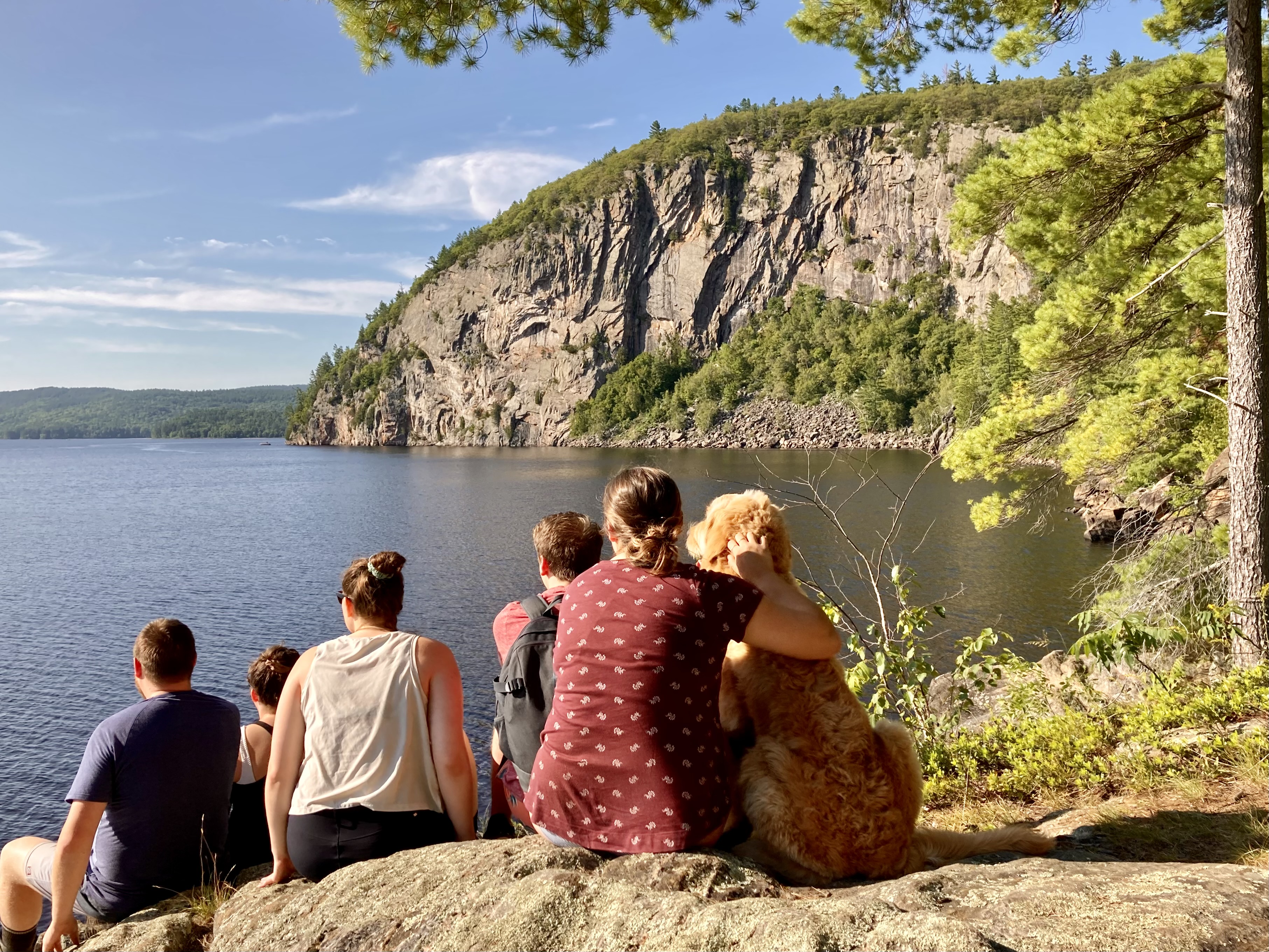
Respecting and thriving on our planet are not mutually exclusive goals. (photo: Oiseau Rock, Ottawa River)
|
About the Author
Dr. Jeremy Whitlock has three decades' experience as a scientist and manager in the Canadian and international nuclear community. Since January 2017 he has worked in the Department of Safeguards at the International Atomic Energy Agency (IAEA) in Vienna, helping to ensure that countries meet their obligations under the Nuclear Non-proliferation Treaty (NPT). Prior to that he worked at Chalk River Laboratories in nuclear nonproliferation and reactor physics. Dr. Whitlock has a B.Sc. in Physics from the University of Waterloo (1988), and an M.Eng. and PhD in Engineering Physics (reactor physics) from McMaster University (1995). Dr. Whitlock is a Past President and Fellow of the Canadian Nuclear Society, and a public speaker and author on nuclear issues – including The Canadian Nuclear FAQ (www.nuclearfaq.ca), a personal website of frequently-asked questions (FAQs) on Canadian nuclear technology. Dr. Whitlock feels that humans and nature can coexist in harmony when technology is used sustainably, and strongly suspects that canoes are the closest humans have come to inventing a perfect machine.
| 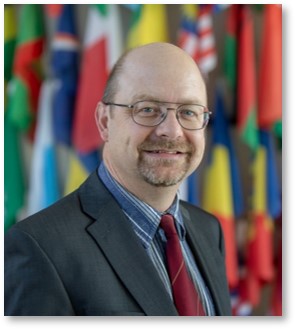
|
The Canadian Nuclear FAQ
|










